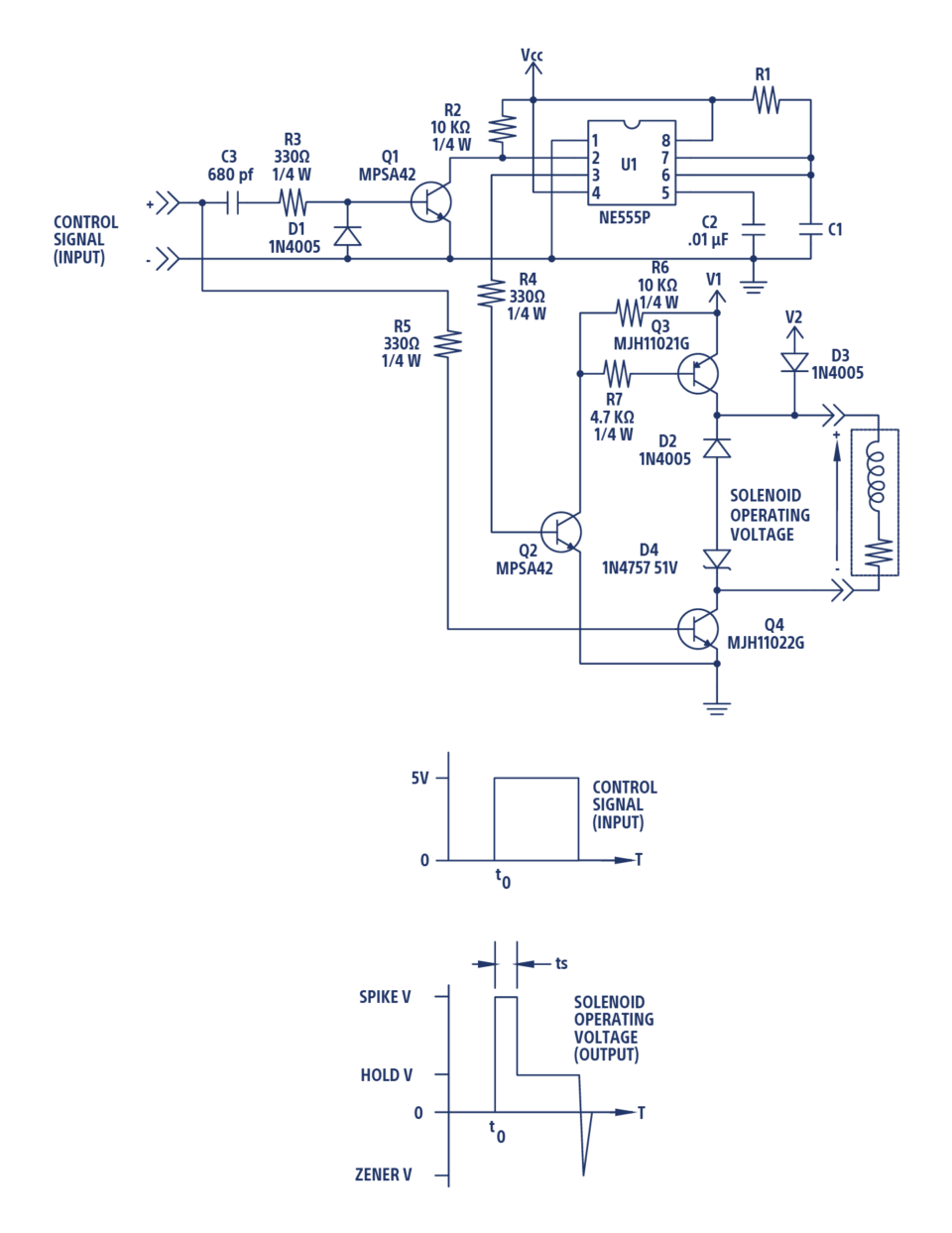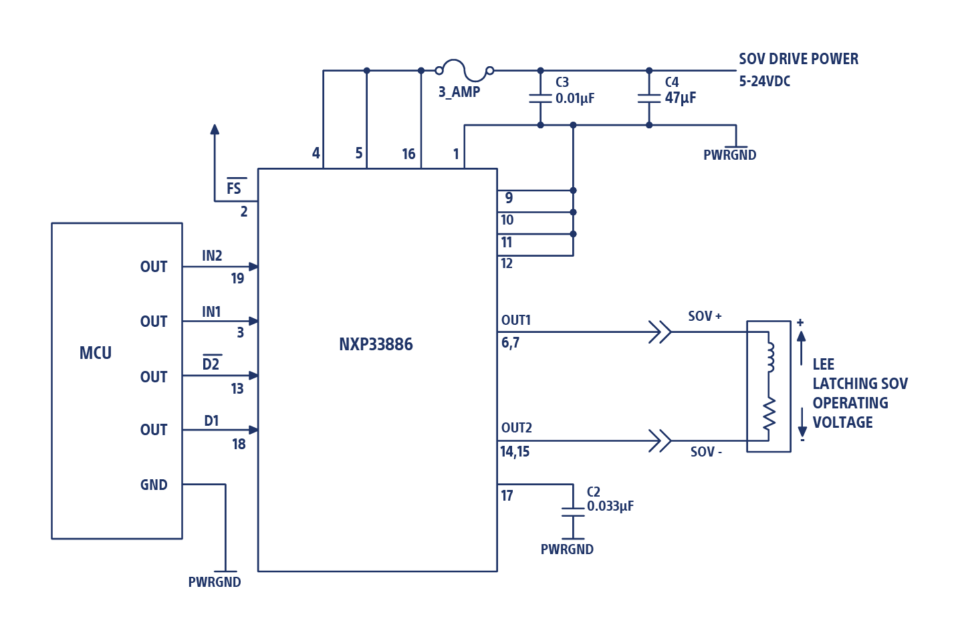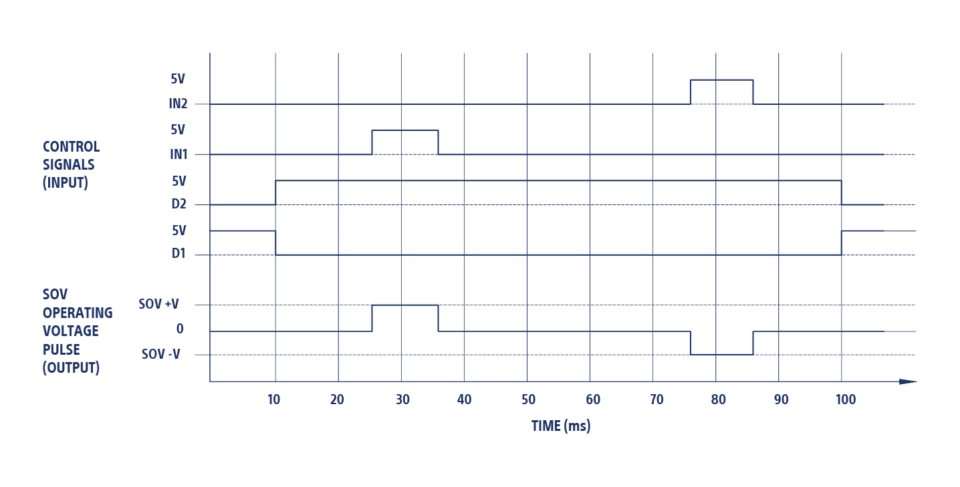Solenoid-operated valves or pumps require an electrical signal to actuate. There are numerous methods to deliver this signal, and, therefore, countless options to consider when designing the necessary electrical drive circuitry; among them are several off-the-shelf options such as PWM chips and mechanical relays.
The Lee Company provides circuit schematics that may be used to drive many of our solenoid-operated valves and pumps. Below, we offer a few specific circuit schematics that may serve as general guidelines; they may be reproduced or modified by the end-user to meet specific application requirements. Contact a Lee Company sales engineer with questions about which circuit is best suited for your application.

The circuit schematic is incomplete and is offered as a basic reference. Contact a Lee Sales Engineer to obtain drawing LFIX1002200A; it includes additional notes and operating instructions.
This schematic demonstrates the simplest form of solenoid drive circuitry, and it may be used to actuate most solenoid-operated valves and pumps. The circuit requires an input voltage (Vcc) to actuate the solenoid and a control signal input (from a controller, function generator, or timing circuit) that switches a transistor. This sequence allows the drive current to energize the solenoid. A diode is placed in parallel with the solenoid to protect the transistor from the inductive voltage spike that occurs as the solenoid de-energizes. A significant voltage drop between the power supply and solenoid may occur if there is unexpected resistance, such as long lead wires or other electrical components. Once the circuit is built, it is important to verify that the solenoid is receiving its rated actuation voltage by measuring the voltage directly across the solenoid’s pins. This circuit may be configured for two different operating modes, depending upon your application requirement:

The circuit schematic is incomplete and is offered as a basic reference. Contact a Lee Company sales engineer to obtain drawing LFIX1002250A; it includes additional notes and operating instructions.
This circuit can be used as either an enhanced response time driver or as a low power consumption driver. The circuit initially supplies a brief actuation voltage (V1, “Spike” Voltage) for a period of time (ts); then it switches to a lower voltage (V2, “Hold” Voltage) to keep the solenoid in an energized state for an extended period of time. The duration of the spike (ts) is determined by a resistor and a capacitor (R1 and C1 indicated on LFIX1002250A, Note 4) connected to a 555 timer chip. Typically, the spike duration is slightly longer than the response time of the solenoid. A control signal input (from a controller, function generator, or timing circuit) is required to actuate the solenoid. The solenoid will remain actuated for as long as the control signal is applied. A significant voltage drop between the power supply and solenoid may occur if there is unexpected resistance, such as long lead wires or other electrical components. Once the circuit is built, it is important to verify that the solenoid is receiving its rated actuation voltage by measuring the voltage directly across the solenoid’s pins. Be sure to employ a differential probe when you use an oscilloscope to measure the signal between the solenoid pins.
This driver may be configured for two different operating modes depending upon whether you require lower power or a faster response.
1. Fast response spike & hold driver – Solenoid response time can be improved for actuation (time to open) and latch-out (time to close) of the solenoid. This may be accomplished by applying an “over-drive” voltage greater than the rated actuation voltage to V1 and by adding a 51V Zener Diode (D4, indicated on LFIX1002250A, Note 5.1). After quickly actuating the solenoid, the driver switches to a lower holding voltage applied at V2 to reduce resistive heating and to avoid damage to the solenoid. When power is removed, a 51V Zener diode placed in series with a flyback protection diode improves the latch-out response (time to close) of the solenoid.
2. Low power consumption driver – Overall power consumption can be significantly reduced (typically by 75-90%) by applying the rated solenoid voltage to V1 and a lower hold voltage to V2. For most solenoids, the hold voltage is half of the rated actuation voltage; be sure to check the valve’s inspection drawing for requirements related to a particular part number. Contact a Lee Company sales engineer for more specific recommendations regarding the voltage or spike duration.


The circuit schematic is incomplete and is offered as a basic reference. Contact a Lee Company sales engineer to obtain drawing LFIX1002350A; it includes additional notes and operating instructions.
The primary advantage of a latching solenoid valve is that power is not required to maintain the valve’s flow state (either open or closed) between actuations. That is, a de-energized latching valve will hold its current flow state. Because of this magnetically latched feature, latching solenoid valves have polarized leads that require a different type of drive circuitry. The flow state of the solenoid is determined by a negative or a positive voltage pulse; this requires a circuit capable of bi-directional current flow. The recommended LFIX1002350A schematic includes an H-bridge chip that reverses the direction of current flow, allowing for effective latching solenoid valve switching. A significant voltage drop between the power supply and the solenoid may occur if there is unexpected resistance, such as long lead wires or other electrical components. Once the circuit is built, it is important to verify that the solenoid is receiving its rated actuation voltage by measuring directly across the solenoid’s pins.
This schematic requires a rated input voltage to actuate the solenoid and to switch commands provided by a microcontroller (MCU) or another programmable logic controller (PLC). Switching commands should be provided as a 5 Vdc “HIGH” or “LOW” signal — four are required. Two pins are required to enable the H-bridge chip, and two pins are required to trigger either a positive or a negative pulse to the solenoid. A description of each pin is included below along with a state diagram. The inspection drawing for each latching solenoid valve provides information about solenoid pin assignments and the porting arrangements.
MCU Pin Assignments (Waveform Graph)
Always verify flow calculations by experiment.
*There are many parameters to consider when determining V-Factor. Click here for more information.